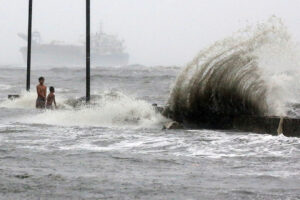
Philippines is still most disaster-prone country for 16th straight year
THE PHILIPPINES remained the most disaster-prone country for the 16th straight year, as it continues to face extreme natural events like typhoons, earthquakes and droughts.
In the latest World Risk Index, the Philippines’ risk score inched up to 46.91 this year from 46.86 last year.
A country’s score is measured based on its exposure to disasters as well as vulnerability to its effects. A score of 100 means a country has a “very high risk” while zero suggests otherwise.
The World Risk Report, published by Germany-based Bündnis Entwicklung Hilft and the Institute for International Law of Peace and Armed Conflict at Ruhr University Bochum (IFHV), assesses the disaster risk for 193 countries using 100 indicators.
The Philippines, which faces an average of 20 typhoons every year, has topped the World Risk Index since 2009.
“In 2024, the risk hotspots remain in the Americas and Asia, hosting eight of the 10 countries with the highest risk scores. Over the long term, however, these hotspots will shift to countries with climate-sensitive exposure and high vulnerability,” the report said.
Indonesia ranked second in the index with a score of 41.13, followed by India (40.96), Colombia (37.81) and Mexico (35.93). The rest of the top 10 included Myanmar (35.85), Mozambique (34.44), Russia (28.12), Bangladesh (27.73), and Pakistan (27.02).
Global disaster risks are also closely linked to poverty and inequality, the report said.
“This persistence often results from robust interactions between increasing vulnerability and damage caused by extreme events. Countries with climate-sensitive exposure and high to very high vulnerability are particularly at risk. These countries can expect more frequent and more intense extreme natural events and damage in the future,” it said.
In terms of exposure to disasters, the Philippines ranked fourth with a score of 39.99. China had the highest exposure (64.59), followed by Mexico (50.08), and Japan (43.67). A high score means a country is most exposed to drought, earthquakes, tsunamis, cyclones, coastal and riverine flooding, and rising sea levels.
“Climate change is increasing the frequency and intensity of extreme natural events, leaving less and less time for regeneration. As soon as one disaster is overcome, the next threat is already looming,” the report said.
The Philippines also had “very high” scores in terms of vulnerability (55.03), susceptibility (51.16), and lack of coping capacities (58.07).
“Extreme weather events, conflicts and pandemics overlap and amplify each other. Global trends such as climate change, population growth and political polarization promote multiple crises and intensify their effects,” the report said.
For instance, the Philippines was hit by 22 typhoons during the coronavirus disease 2019 (COVID-19) pandemic, including Supertyphoon Rolly (international name: Goni) which was considered one of the strongest ever.
“Hundreds of thousands of destroyed homes, overcrowded evacuation centers and the resulting increase in COVID-19 cases not only led to a dramatic increase in humanitarian needs, but also had a negative impact on the mental health of the population,” the report said.
Terry L. Ridon, a public investment analyst and convenor of think tank InfraWatch PH, said the Philippines’ tight fiscal space has affected risk mitigation measures.
“While government has disaster and climate bodies which craft policy relating to adaptation and mitigation measures to address disaster and climate risks, government offices have not yet done enough to actually implement climate resilient programs and projects,” he said in a Viber message.
“A particular reason for this is our limited fiscal space, in which fundamental social services and infrastructure are the most important spending priorities.”
Typhoons may have cost the Philippine economy around $20 billion in gross domestic product losses from 1990 to 2020, the Asian Development Bank said in a 2021 report.
The Philippine government should come up with ways to make its key projects or programs more climate-responsive or climate-resilient, Mr. Ridon added.
Leonardo A. Lanzona, who teaches economics at the Ateneo de Manila University, said the Philippines has a high risk of disasters due to its vulnerability to climate change.
“If institutions are strong, there are ways of mitigating the effects of extreme weather conditions in the country. Climate is one significant challenge we face, and our institutions are powerless in protecting our properties and lives. I am thinking of corruption, and flood control funds can be diverted into their interests,” Mr. Lanzona said. — Beatriz Marie D. Cruz



